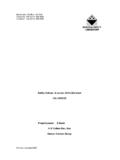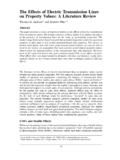Transcription of Strengths and weaknesses of available methods for ...
1 _____ 1 Strengths and weaknesses of available methods for assessing the nature and scale of harm caused by the health system: literature review By Philippe Michel WHO commissioned Philippe Michel of the Comit de Coordination de l valuation Clinique et de la Qualit en Aquitaine (CCECQA) to carry out a literature review on methods for assessing the nature and scale of harm caused by health systems. The objective of the study was to identify the Strengths and weaknesses of available methods . The study, which was completed in December 2003, is a contribution to the discussion of patient safety issues.
2 The author alone is responsible for the views expressed in this paper. He is grateful to Jean Luc Quenon (CCECQA) who wrote the sections dealing with reporting systems, and with claims and complaints, and is indebted to Charles Vincent for his useful comments. He wishes to thank Emmanuelle Blondet, Sylvie Lascols and Vincent Mounic, of the Agence Nationale d Accr ditation et d Evaluation en Sant (ANAES), France, for their help in the literature search and retrieval.
3 _____ 2 Contents Abstract 4 1 Introduction 7 Objective 8 2 literature review 8 Study design 8 Search strategy for articles 8 Selection criteria for articles 9 Definitions 9 Criteria for evaluating assessment methods 10 Data analysis
4 11 Results of the literature search 13 3 Strengths and weaknesses of available methods 16 review of medical records 16 Studies based on interviews with health -care providers 22 Direct observation 24 Incident reporting systems 26 External audit and confidential inquiries 30 Studies of claims and complaints 32
5 Information technology and electronic medical records 35 Administrative data 38 Autopsy reports 40 Mortality and morbidity conferences 42 4 Focus on the literature from developing countries and transitional economies 44 5 Discussion and conclusions 49 References 50 _____ 3 ABSTRACT This report describes the Strengths and weaknesses of available methods for assessing the nature and scale of harm caused by the health system, according to a defined set of criteria.
6 These criteria, and the available methods , were identified during a WHO Working Group meeting on Patient safety: rapid assessment methods for assessing hazards, held in Geneva, Switzerland, 17-19 December 2002. Study design The author and his colleagues conducted an extensive search of the Medline database and other sources to identify methods for estimating hazards. methods included: ad hoc studies based on epidemiological designs and systematic data collection ( review of medical records, studies based on interviews with health care providers, direct observation); institutional and national reporting systems; external audits and confidential enquiries; analysis of existing and routinely collected data (studies of claims and complaints; information technology and electronic medical records; administrative data; autopsy reports.)
7 And mortality and morbidity conferences). The criteria used to select methods for the present study were effectiveness in capturing: the extent of harm; availability of reliable data; suitability for large-scale or small, repeated studies; costs (financial, human resources, time and burden on system); effectiveness in influencing policy; effectiveness in influencing hospital and local safety procedures and outcomes; and synergy with other domains of quality of care.
8 We considered the level of evidence of published literature for rating each method on each of the criteria. When evidence-based data were available , we used a four-item scale (from + to ++++). In the absence of valid data, we presented the results in a separate table using a different rating presentation (from 1 to 4), reflecting authors opinions. Both ratings were considered in relation to information-rich environments. In a separate analysis, we considered the literature from developing countries.
9 Here the small number of articles did not make it possible to extract sufficient evidence-based data, and the opinion-based rating from 1 to 4 was used. Results A total of 262 articles were selected for inclusion in the study, from 1828 retrieved references. The relevance of each method is summarized in Table 1 according to the purpose of the user, defined in terms of scope (harm, active error or latent error) and objective (adverse event counting or understanding).
10 Table 1 Overview of methods with respect to their relevance for specific purposes Adverse event counting (frequency assessment) Method Harm Active errors Adverse event understanding (root cause analysis) latent causes / contributory factors review of medical records X X ?

















